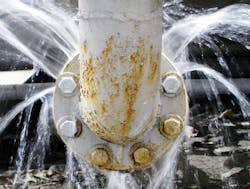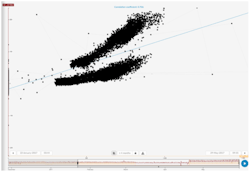About the author:
Bavo Symens is data analytics engineer for TrendMiner. Symens can be reached at [email protected].
Clean water is an essential requirement for human health, environmental sustainability and economic development. Due to population growth, urbanization and climate change, this vital resource has become more scarce than ever in communities around the world. To meet the needs for increasing demand, there is a growing need for societies to shift towards a more circular economy, but it comes at a cost. Instead of discharging wastewater, it needs to be captured, treated and distributed back to the consumer.
Water reuse and wastewater treatment are intrinsically energy intensive, due to the need to move large volumes of water using pumps and electric motors and then treat the water to meet regulatory requirements. In conventional wastewater treatment plants (WWTPs), aeration is one of the biggest—if not the biggest—energy consumer for treating wastewater. Other significant energy consumers include filtration and disinfection processes, depending on the application.
To cope with increasing energy consumption and to reduce the carbon footprint in water industries, new technologies need to be implemented. Innovative technologies in water reuse facilities often come with drawbacks, such as increased complexity and increased reliance on instrumentation. These challenges in energy management are not unique to the water industry; they also are of concern in other industries, including the chemical, food and beverage, metal and mining, pharmaceutical, and oil and gas industries. Energy management has become more important in recent years due to established regulations to reduce greenhouse gas emissions on a national, regional and local scale. To achieve these goals and to comply with regulations, the oil and gas industry in particular is rapidly adopting the ISO 50001 standard to improve energy performance and make it part of their corporate strategy. Most companies have formalized the energy management programs and use automation and control technologies to help minimize energy costs. It is clear, however, that many companies need to take their efforts to the next level by monitoring and optimizing energy use in real time, and leveraging Industrial Internet of Things (IIoT)-generated data.
For many years, process data has been retained and maintained with historians. All this data can be unlocked and leveraged for continuous improvement of processes and to lower carbon footprints. To some extent, data analytics has been utilized by major companies for their larger onsite energy issues, but this requires significant resources. These time-consuming, centrally led, data modeling projects are less suited for process-related optimization projects that require subject matter expertise. In recent years, new tools have become available that place advanced analytics in the hands of subject matter experts, including process and field engineers. These tools enable such experts to solve energy process-related cases independently, and positively contribute to corporate goals for reducing carbon footprints.
Energy Management 4.0
Global interest in Industry 4.0 has accelerated digital transformation in the process manufacturing industry, including water-related industries. Many companies have engaged in technology pilots to explore options for reducing costs, to increase overall equipment effectiveness and to help conform to regulatory compliance. Anaerobic membrane bioreactors (AnMBR) are used in WWTPs to separate and treat sludge from wastewater, generating biogas as a byproduct. This technology can drastically reduce the energy consumption in large plants by generating renewable energy on site. Microbial electrical systems can be used to generate electricity while treating wastewater with microbial fuel cells, for instance, but work on this is still in its early stages of development. Aeration is a key consumer in wastewater facilities, and a lot of research has been conducted in an effort to optimize these processes.
To give some examples, membrane-aerated biofilm reactors are an emerging technology in which oxygen is transferred more efficiently. Optimizing the configuration and hydrodynamics in large bioreactors can provide better mixing. This, consequently, leads to less energy consumption for aeration and can even result in less production of strong greenhouse gases such as nitrous oxides and methane.
Disinfection and filtration processes can contribute significantly to the total energy consumption. This depends largely on the level of water quality standards required for the application. Novel technologies, such as ultraviolet disinfection using LEDs, can reduce energy consumption. Also, improved membrane technologies, such as ultrafiltration and reverse osmosis (RO), are gaining more attention for reducing energy impact.
One way to leverage these new technologies is to apply advanced industrial analytics to production data generated by sensors. Every piece of data provides opportunities for improving energy efficiency. As data is only as valuable as the solutions it unlocks, understanding its potential is key. Complex optimization problems frequently are tackled by a limited group of data scientists who use the data for building and validating mathematical models. For instance, computational fluid dynamics modelling is gaining traction in the water industry.
Another strategy is to empower subject matter experts—such as process, operation and maintenance engineers—who have deep knowledge about the production process itself. If they can quickly access, search and analyze the historical time series data, they will be able to answer relevant questions for their day-to-day jobs without having to rely on data scientists. Hypothesis generating and hypothesis testing by using descriptive, discovery, diagnostic and even predictive analytics has already proven its value in many other industries.
Practical Use Cases
Before starting any energy management project, it is crucial to first define your problem and identify the high-energy consumers. Using descriptive analytics, one can benchmark optimal operating conditions. Such benchmarks or reference periods can be used to assess cost saving opportunities and set priorities for optimization projects. Optimal operating conditions can be used to configure monitors using discovery analytics. Leaks can be detected if levels in tanks decrease abnormally fast. Alerts can be received when sensors need to be replaced or calibrated. When flow control valves start to wear out or get plugged, this information can be captured within the data. Fouled membranes cause increased hydraulic head losses. This change of behavior is expressed in time-series data and can be identified by the appearance of different operating windows in scatter plots (See Figure 1, page 56). These anomalies can be detected and used as a premise to prompt people in the field to take action, as was seen at PWN.
PWN is a water company located in the Netherlands that used time-series data to calculate the hydraulic head to analyze and monitor the performance of its water network. It became clear that the hydraulic head losses were increased after construction works. This descriptive analysis enabled the engineers to distinguish between the two operating zones.
A similar approach can be used to optimize and follow up the performance of pumps by comparing the actual pump performance curve to the pump performance curves of the manufacturer. This comparison can provide insights to the energy efficiency of the pumps. The current state of the installed system can be monitored live and used to better predict the need for possible maintenance.
Covestro, a chemical company, initiated three major energy savings projects for its polyether plant in Antwerp as part of the energy savings goals and ISO 50001 directives. Self-service analytics solutions were implemented for online detection, logging and explaining unexpected energy consumption and comparing the results with the reference year 2013.
Using specific formulas and calculated tags, various energy consumers were monitored and controlled. Through monitoring the performance against the reference year, the energy consumption was effectively decreased year over year, meeting corporate goals. More importantly, with a growing knowledge and insight into the production process, Covestro continues to improve its overall performance.
Diagnostic analytics can help process engineers troubleshoot and gain more insight into processes. Comparing different regeneration cycles in ion exchangers can help the investigation into the effect of multiple process parameters on performance. By overlaying multiple runs, hypotheses can be tested with historical data. An example of this is the monitoring and quantification of the effect of feed composition, temperature or pH on the quality of the biogas production in AnMBR systems. Visualising the relevant data in the correct way helps engineers to gain new insights.
Evides, a Dutch water company, found that significant energy could be saved by using a redundant RO skid to deliver the same production rate. This became clear after preprocessing and filtering the relevant data of a reverse osmosis unit at an industrial WWTP in Antwerp.
Raising Awareness
To meet the needs for a global increase in water demand, there is a growing need for societies to shift towards a more circular economy. Instead of just discharging wastewater, it needs to be captured, treated and distributed back to the consumer, but this takes a lot of energy and significantly increases the carbon footprint. With ever-evolving environmental regulations, the water industry must think of new ways to increase energy efficiency.
Energy management is not new. Many companies have structured energy management programs in place. However, such programs often require the use of data scientists, which can delay the time it takes to find process solutions and overlook the precious insights subject matter experts can offer.
New self-service analytics tools bring the subject matter experts to the forefront of the analytical process by enabling them to analyze, monitor and predict process and asset performance. This can significantly contribute to the meeting of organizational carbon footprint goals, especially when process knowledge is needed to improve operational performance, and asset reliability.
Typically, these improvements come together with an improved overall profitability and increased safety. Therefore it is critical to raise data analytical awareness in all energy-intensive industries to reduce the carbon footprint.

